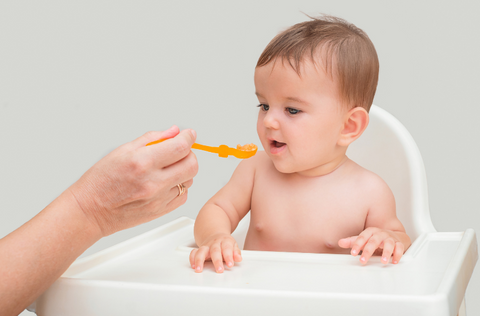
Signs baby is ready for solid foods:
✔️Tongue thrust subsides
If your baby consistently pushes the spoon away with their tongue or struggles to swallow solids, it's an indicator that they might not be ready for solid food just yet. Give it another shot in about a week. It's completely normal for some food to come out from the corners of your baby's mouth at the beginning. It will get better as they develop their oral motor skills.
✔️Baby can sit up & stay in sitting position, hold head steady
It’s best to wait until your baby can sit upright with the support of a chair and keep his head up. Starting solid foods before a baby can hold their head up might lead to difficulties in swallowing and increased risks of choking.

✔️Eye, hand & mouth coordination
Your baby should be able to look at food, pick it up and put it in their mouth on their own. Having good eye, hand and mouth coordination means your baby will be better equipped to handle the process of introducing solid foods. They will have better control over their movements and can manage the transition from liquid to solid foods more safely.
✔️Still hungry after milk
When your baby seems constantly hungry even after nursing, it can actually be a subtle sign that they might be ready for the next step in their feeding journey. While breast milk or formula will remain essential for their nutrition, incorporating different textures and flavours can offer more variety in their diet.
✔️Shows interest in what you are eating
Another subtle sign, but worth keeping an eye out for is when your baby starts getting interested in food or reaching towards your food. Always remember to pay attention to all of your baby's cues and talk to your paediatrician before you begin introducing solid foods.
Start Small
Begin introducing solid foods with 1 to 2 teaspoons in the initial stages. During the early stages of weaning, focus more on getting your little one used to new tastes and textures of something other than milk. Don’t be worried about the quantity given because most of your baby’s nutritional needs are still being met through breast milk or infant formula at this point. In time, you’ll be able to increase the amount of solid food they eat.
Moving Forward
As you progress, gradually increase the quantity of solid food to 1 to 2 tablespoons, incorporating it into their routine 2 to 3 times daily. As your baby becomes accustomed to the weaning process, you can progressively increase their portion sizes until it constitutes a complete meal, potentially replacing one of their milk feedings.
Your baby knows best! Listen to your little one to determine the amount of milk (whether breast milk or formula) or food to give.
Get flavourful baby food delivered to your doorstep
If you’re looking for a variety of dietician-approved baby food, explore our selection of congee, porridge, and stews suitable for babies aged 6 months and older.
Your little one’s first foods set the nutritional foundation for their future. Let’s make those spoonful count!
Reference
World Health Organization (2023) Breastfeeding [online]. Available at: https://www.who.int/health-topics/breastfeeding#tab=tab_1 [Accessed: 21 Aug 2023]

